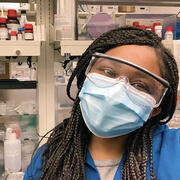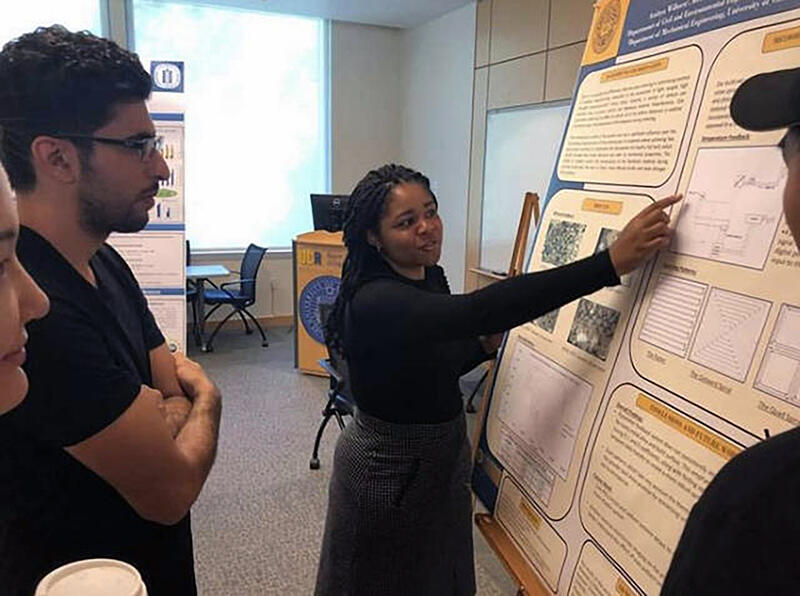
This materials scientist is enabling soft robots to make complex moves
By Adam Zewe
In the future, soft robotics will play a major role in our everyday lives. They could be incorporated into ultra-thin wearable devices or be injected into the bloodstream to deliver medicine to the site of a tumor.
Those mind-boggling applications inspire materials science and mechanical engineering Ph.D. candidate Milan Wilborn and drive her work on soft actuators at the Harvard John A. Paulson School of Engineering and Applied Sciences and Graduate School of Arts and Sciences.
In the lab of Joanna Aizenberg, Amy Smith Berylson Professor of Materials Science, Wilborn is using liquid crystal elastomers, soft materials that can bend or deform in response to heat, light, or humidity, to create soft actuators that can move in complex ways.
“It is really exciting to be working on something cutting edge and to be a part of something that I care about,” Wilborn said. “I like that I have the opportunity to be part of a project that I could see being applied in ways that are meaningful.”
The opportunity to make a meaningful impact for communities is what drew Wilborn to engineering in the first place.

|
Wilborn presents her poster to fellow lab mates at UC Riverside. Photo courtesy of Milan Wilborn |
She studied civil engineering at Northeastern University because building safer bridges and improving infrastructure seemed like concrete ways to help a lot of people.
During an internship at an environmental engineering firm in Baltimore, Wilborn worked on remediating the soil contamination at the site of a shuttered iron factory. A second internship for a structural engineering firm in Boston sent her out to inspect tunnels and bridges throughout the city.
While she enjoyed the field work, Wilborn surprised herself by gravitating toward academic research.
She joined the lab of Associate Professor Loretta Fernandez, where she took samples from bodies of water around Boston and analyzed pollutants in an effort to determine their sources.
“I never knew what research was, or what the goals were, until I joined that lab,” she said. “What appealed to me was digging in and being able to really, fully understand a problem.”
She flexed her newfound research muscles at the University of California, Riverside, where she worked in the lab of Professor Suveen Mathaudu to develop super lightweight metals and ultrafine grain materials.
Those research experiences inspired her to pursue a Ph.D. at Harvard with a focus on materials science.
“As an undergrad, I learned about how nature structurally engineers systems. I studied bamboo, and how it has high tensile strength, similar to steel,” she said. “That was something that always stuck with me—that natural systems will engineer themselves in ways that we either intentionally or unintentionally mimic. I thought that was really cool about materials science.”
At Harvard, she became particularly interested in smart and adaptive materials, and their implications in so many realms, from information technology to health care. Wilborn applied her skills by joining three other grad students to develop a wearable navigation aid for the visually impaired that uses cutting-edge soft robotics and computer vision technology. Foresight, the startup they launched based on the project, won the Innovation Award in the 2020 Harvard President’s Innovation Challenge.
"The biggest challenge of my research, of any academic research, comes from the idea that you are trying to be unique in what you are doing" |
- Milan Wilborn |
Wilborn continues to be fascinated by soft mechanics and systems that respond in ways that are almost living, as she delves deeper into materials science.
“The biggest challenge of my research, of any academic research, comes from the idea that you are trying to be unique in what you are doing. So when you run into problems, there is no internet search that can find you a solution,” she said. “You have to figure it out, with the help of all the people around you and all the people in the broader community. You have to solve a problem that didn’t exist before.”
She’s motivated by the potential her work holds to impact the field and drive materials science forward. While it is still early days for Wilborn, she is intrigued by the idea of working for a startup, or founding her own, which would incorporate cutting edge materials into new technologies that could help people.
It’s a future she couldn’t have imagined even a few years ago, when she was knee deep in a river collecting water samples or inspecting a crumbling bridge trestle, but one that fills her with excitement.
“The best advice I can give any student is to talk to people. As an undergrad, you’re really focused on getting good grades and checking all the boxes, but at the end of the day, it is about knowing people who have done the things you want to do, who look like what you want to look like,” she said. “The most important thing that has gotten me to where I am is people who have helped me along the way, and those who continue helping me in the highly collaborative Aizenberg lab.”
